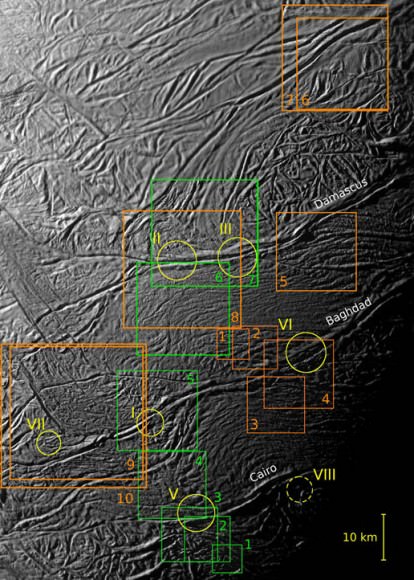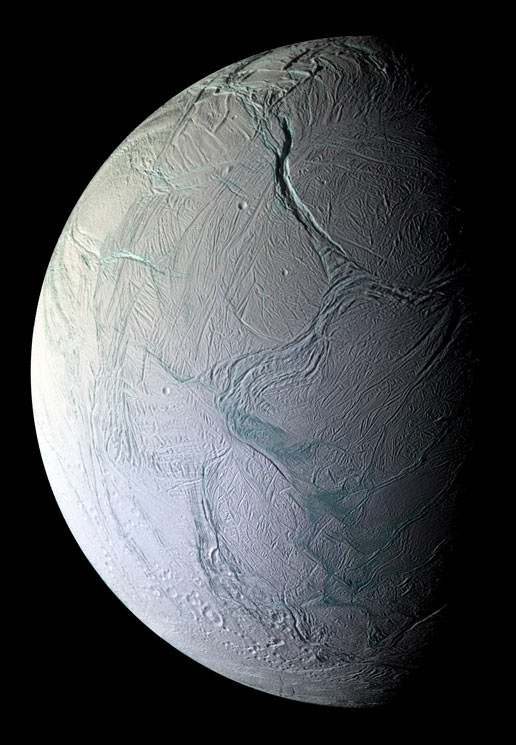[/caption]
Saturn’s moon Enceladus not only has jets of water vapor spewing from vents on the southern hemisphere, but the moon’s surface in the same region shows evidence of changes over time, providing surprising indications of Earth-like tectonics. New high resolution images from the Cassini spacecraft’s recent flybys of Enceladus show close views of the moon’s distinctive “tiger stripe” fractures, yielding new insight into what may be happening inside the fractures. “Of all the geologic provinces in the Saturn system that Cassini has explored, none has been more thrilling or carries greater implications than the region at the southernmost portion of Enceladus,” said Carolyn Porco, Cassini imaging team leader.
A special spacecraft maneuver dubbed “the skeet shoot” was employed to make smear-free imaging at close range possible. The ground track of the camera’s pointing was selected to cut swaths across three tiger stripes, or sulci, the prominent rifts through which jets of water vapor and ice particles are actively jetting. The full-resolution images are absolutely astounding. Take a look at the large images and movies here.
Cassini’s flybys on Aug. 11 and Oct. 31 of this year targeted Enceladus’ fractured southern region, and an Oct. 9 flyby took the spacecraft deep into the plume of water vapor and ice shooting out of the moon’s vents. Interestingly, the plume is not constant varies over time. Scientists think that condensation from the jets erupting from the surface may create ice plugs that close off old vents and force new vents to open. The opening and clogging of vents also corresponds with measurements indicating the plume varies from month to month and year to year. This movie shows the locations of the vents on a “spinning” Enceladus.
“We see no obvious distinguishing markings on the surface in the immediate vicinity of each jet source, which suggests that the vents may open and close and thus migrate up and down the fractures over time,” Porco said. “Over time, the particles that rain down onto the surface from the jets may form a continuous blanket of snow along a fracture.”
The varying cloud of vapor and particles extends into space and has a far-reaching effect on the entire Saturn system by supplying the ring system with fresh material and loading ionized gas from water vapor into Saturn’s magnetosphere.

But most interesting is the evidence of movement of Enceladus’ surface, called “spreading.”
“Enceladus has Earth-like spreading of the icy crust, but with an exotic difference — the spreading is almost all in one direction, like a conveyor belt,” said Paul Helfenstein, Cassini imaging associate at Cornell University in Ithaca , N.Y. “Asymmetric spreading like this is unusual on Earth and not well understood.”
“Enceladus has asymmetric spreading on steroids,” Helfenstein added. “We are not certain about the geological mechanisms that control the spreading, but we see patterns of divergence and mountain-building similar to what we see on Earth, which suggests that subsurface heat and convection are involved.” This video demonstrates the observed tectonic spreading along tiger stripes in the South Polar Terrain of Enceladus.
The tiger stripes are analogous to the mid-ocean ridges on Earth’s seafloor where volcanic material wells up and creates new crust. Using Cassini-based digital maps of the south polar region of Enceladus, Helfenstein reconstructed a possible history of the tiger stripes by working backward in time and progressively snipping away older and older sections of the map. Each time he found that the remaining sections fit together like puzzle pieces.
With water vapor, organic compounds and excess heat emerging from Enceladus’ south polar terrain, scientists are intrigued by the possibility of a liquid-water-rich habitable zone beneath the moon’s south pole.
Cassini’s next flyby of Enceladus will be in November 2009.
The Cassini team presented their findings and recent images at the American Geophysical Union’s fall meeting in San Francisco.


Enceladus is growing.
Why dont we send an atomic bomb to blow a hole into one of these stripes and see if there is water underneath.
like glacier maybe?=)
In the “Enceladus’ Jets” movie (http://ciclops.org/view_media/26431/Enceladus_Jets) you can possibly see another example of spreading. If you look closely you may notice that the ridges form something akin to an irregular pancake, like a cap on the top of the moon. This is so cool and unexpected. Who would have thought just a few years ago that *Enceladus* of all the places is one of the more active bodies geologically speaking and that this seemingly dead snowball of a world would play a vital role in the formation and sustaining of the rings of Saturn!
This yet another proof that saving on science is, emm… , not so smart. There is no telling what’s “around the corner”.
/Adam
But then there are the calculations: “The heating in Enceladus in an equilibrium resonant configuration with other saturnian satellites can be estimated independently of the physical properties of Enceladus. We find that equilibrium tidal heating cannot account for the heat that is observed to be coming from Enceladus. Equilibrium heating in possible past resonances likewise cannot explain prior resurfacing events.” -Jennifer Meyer and Jack Wisdom, MIT; “Enceladus …shows evidence of recent resurfacing, yet the standard estimates of tidal heating, the only viable source of heating, are too small to account for the observed activity.” J. Wisdon, MIT. Methinks alternate theories are in order.
Reminds me of an egg, ready to hatch.
Why not see if we can model the creation of a cover shell over one of the regions where there is an exhaust of water vapour. That implies pressure, and pressure implies that we might be able to create a wet, but pressurised chamber within which we might be able to live for long periods. The constant out gassing of the water vapour providing all sorts of benefits such as energy for generating electricity ……….. Free energy for the long term development of a base.
If we need a way-station between Earth and the Kyper Belt, for example, then perhaps this is the best candidate? We could build the structure from ice using the same techniques used during WW2 to create ice based concrete structures.
Indeed, if we dig into the surface we can use the technologies developed in the Antarctic to create exactly the same type of systems for long term inhabiting the moon.
Here we go again, is it ours to the taking?
“Here we go again, is it ours to the taking?”
I don’t see anyone else’s name on it.
I also noticed that there are some craters on the moon. Has anyone been able to date them? Would it be possible that the object that hit the moon survive to settle on the sea bottom?
It looks like stretch marks in the initial stages of decomposition. Well they say Tiamat lives there…probably feeding off the enormous marine life deep under the surface. I am in agreement with the US government, in that we should just nuke the place and call it good.
Does Jupiter has a land for spacecraft to land?
Just another good example for the Growing Planets Theorie. Wonder when the first official scientist is brave enough to use the word “growing”, but the consequences are still to severe, so we will have to wait.
That’s Too nice, when it comes in india hope it can make changes for you.. hope that come true.